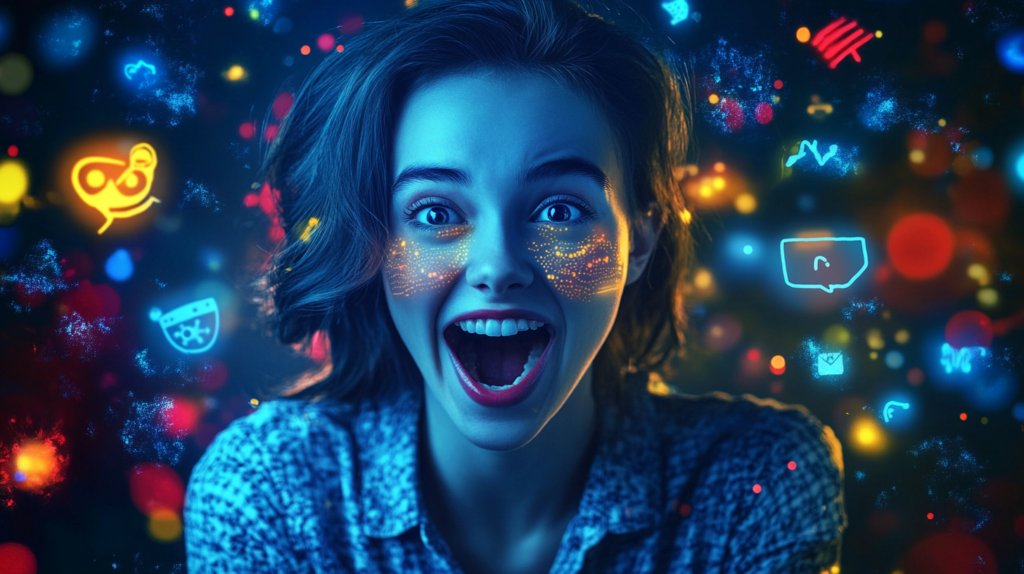Table of Contents
Ready to take your ad creation to the next level? In this article, we’ll walk you through the entire process of crafting a high-converting online product ad. First, we’ll show you how to use ChatGPT to generate compelling, attention-grabbing copy. Next, we’ll explore how to create eye-catching visuals with Midjourney that are sure to capture attention. Finally, we’ll bring everything together in Canva, demonstrating how these powerful AI tools can save you both time and effort. By the end,you’ll see how easy it is to streamline your ad creation process and produce professional-quality ads with ease.
1. Effortless Copywriting with ChatGPT for High-Converting Ads
ChatGPT helps you craft high-quality ad copy within minutes. Here’s an example of an effective prompt:
Prompt example on ChatGPT.com: Create a compelling Facebook ad copy to promote a new line of organic, low-sugar sodas. The ad should appeal to health-conscious individuals and those who appreciate natural, clean ingredients. Highlight the refreshing taste, organic ingredients, and low sugar content. Encourage the audience to switch to a healthier, guilt-free soda option they can enjoy anytime. Include a strong call-to-action that invites them to try it now. Include a title for the post.

After inputting this prompt into ChatGPT, here’s the result:
Title: Sip Into Something Refreshing & Guilt-Free 🌱🥤
Ad Copy:
Tired of sugary sodas but still crave that refreshing fizz? It’s time to make the switch! Introducing [Brand Name]—your new go-to soda, made with organic ingredients, low sugar, and packed with delicious, natural flavor! 🍋🍓🍊
Finally, a soda that’s as clean as it tastes—no artificial sweeteners or chemicals, just real ingredients you can trust. Whether you're sipping at the gym, by the pool, or during a busy day, enjoy guilt-free refreshment whenever you need it!
🌿 100% Organic Ingredients
🍃 Low in Sugar, Big on Flavor
😋 Perfect for Any Time of Day
Ready to elevate your soda game? Click below to try it today and taste the difference!
👉 Try [Brand Name] Now & Experience Refreshment Without the Guilt!
#DrinkClean #GuiltFreeSoda #HealthyRefreshment #OrganicSoda
Refine as needed to achieve the desired result.
2. Create Eye-Catching Product Images Using Midjourney in Minutes
To create stunning images, Midjourney is the perfect tool. Let’s use our previous example to generate an image for the product. First, head over to Midjourney.com and enter this prompt:
Prompt example in midjourney: product photoshoot for an organic soda, soft professional lighting, vibrant green backdrop, photorealistic

Midjourney generates four images—choose the one that best aligns with your vision:

Click on the image, then select ‘Upscale (Subtle)’ to enhance it.

You’ll receive a high-quality, upscaled version of the image:

3. Enhance and Polish Your Product Visuals with Canva’s Easy Tools
In Canva, you can easily add text or apply design presets. In this example, we’ll remove the background, making the image easier to use online.
Start by heading to Canva.com and importing the image:
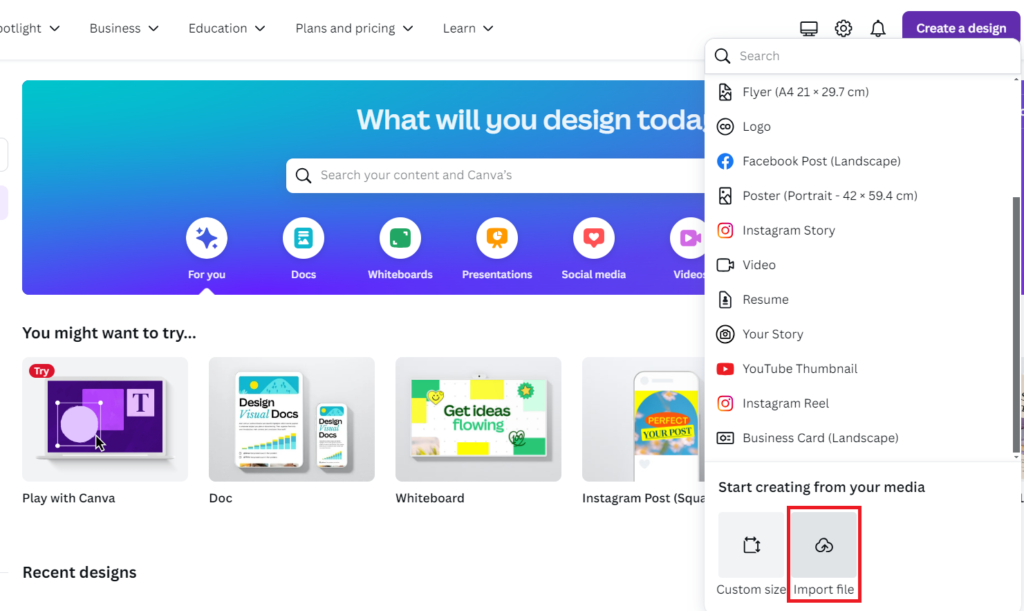
Next, click on ‘Edit Image’:

Click on “BG Remover”
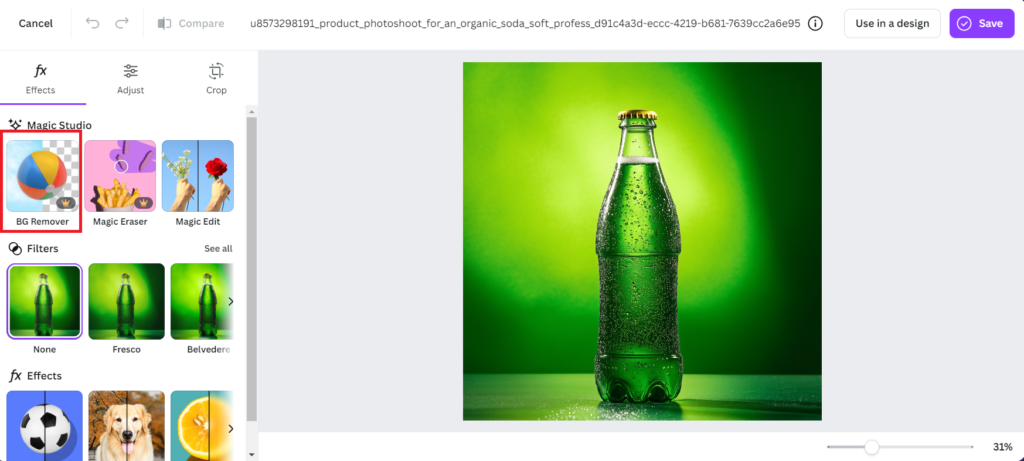
And that’s it! You’ve removed the background.
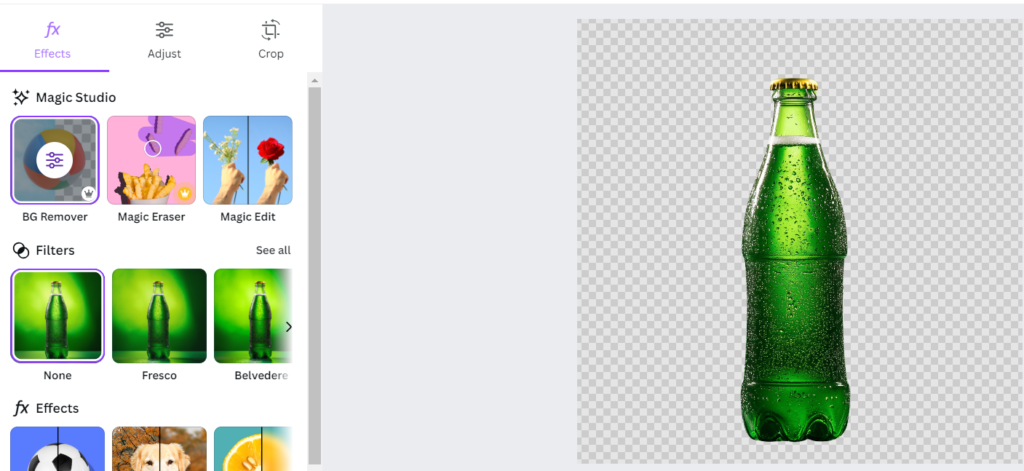
Here is the result:
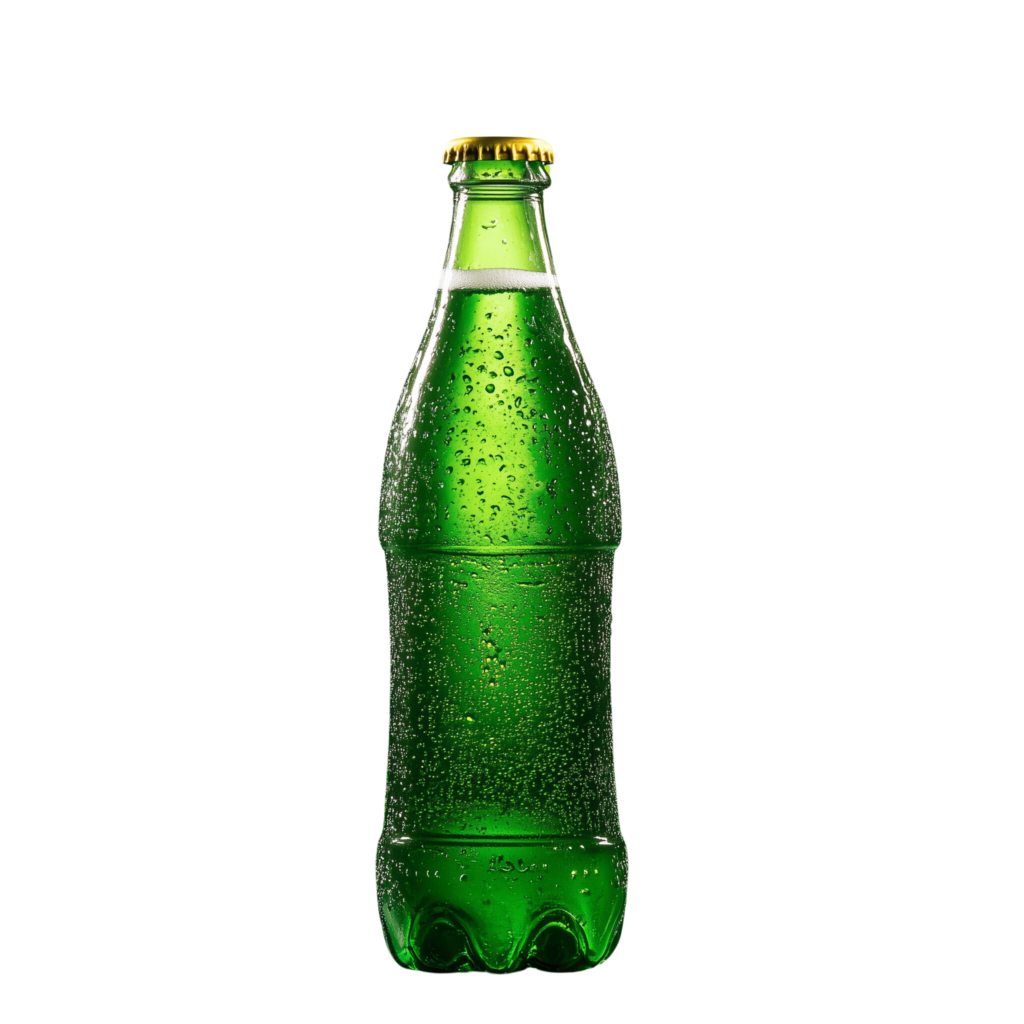
To recap, we’ve crafted a complete copy for our post, including a compelling title and an engaging call to action. Next, we used Midjourney to generate a placeholder image, perfect for enhancing the visual appeal of our social media post. Afterward, we turned to Canva to further refine the image, removing the background for a cleaner, more professional look.
This process highlights how powerful and efficient AI tools like ChatGPT can be for creating high-quality content, while seamlessly integrating with other platforms to achieve a polished, cohesive final result. We hope this walkthrough inspires you to explore these tools to elevate your own content creation process.
Why AI-Generated Ads are Outperforming Traditional Methods
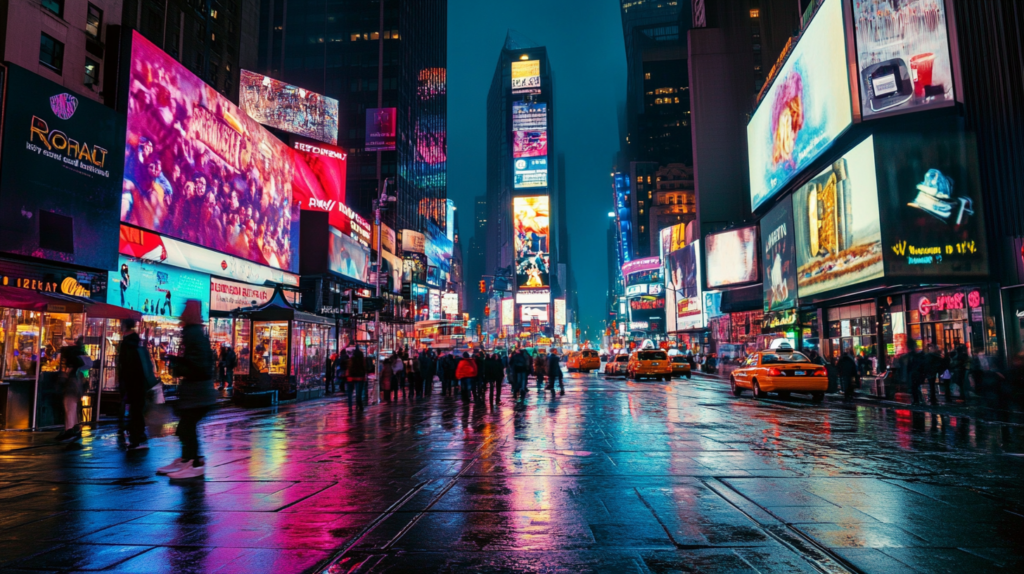
AI-generated ads are rapidly changing the advertising landscape, offering distinct advantages over traditional methods. These benefits are driving more brands to adopt AI tools for their marketing campaigns.
Speed and Efficiency
Traditional ad creation is often time-consuming, involving multiple stages from brainstorming to production and editing. AI tools can create and deploy ads in a fraction of the time. They can produce hundreds of ad variations in just minutes, allowing businesses to respond quickly to market changes and customer trends.This efficiency is vital in fast-paced digital markets where being timely is key to staying competitive.
Cost-Effectiveness
Creating ads the traditional way involves significant costs, such as hiring creative professionals, conducting market research, and managing production. AI-powered solutions reduce these costs by automating the entire process, from content creation to campaign deployment. Many AI platforms generate ads that are as visually and textually compelling as those made by human teams but at a fraction of the cost. This makes AI-generated ads an attractive option for small businesses with limited marketing budgets.
Scalability and Personalization
AI excels at creating personalized ads at scale. Traditional methods struggle with this, as tailoring individual ads for different customer segments is time-consuming and costly. AI algorithms analyze consumer behavior and preferences in real-time, allowing brands to create hyper-personalized ads that resonate with individual users. This level of targeting improves engagement, conversion rates, and overall ad effectiveness.
Continuous Optimization
AI tools can also continuously optimize ad campaigns based on real-time performance data. Traditional ads often follow a set-and-forget approach, where optimization comes after an ad has already been live for some time. In contrast, AI uses machine learning to tweak and adjust campaigns as they run, ensuring optimal performance and minimizing wasted ad spend.
Creative Freedom and A/B Testing
AI-generated ads enable marketers to test different ad variations quickly. Instead of producing one ad and hoping it performs well, marketers can use AI to create multiple versions, test them simultaneously, and refine their approach based on what works best. This not only improves creative output but also helps businesses find the most effective strategies faster.
In summary, AI-generated ads offer faster production, cost savings, personalized targeting, and ongoing optimization, making them superior to traditional methods in many aspects. For businesses seeking efficiency and scalability, AI is an invaluable tool for modern advertising.
SEO Best Practices for AI-Generated Ad Copy

AI-generated content can be incredibly powerful for crafting product ads quickly, but to maximize its SEO effectiveness, it’s important to follow best practices. Here’s how to ensure your AI-generated ad copy is optimized for search engines:
- Human Oversight and Expertise: While AI tools like ChatGPT can generate content quickly, it’s essential to review and refine it with human expertise. Google’s EEAT (Experience, Expertise, Authoritativeness, and Trustworthiness) guidelines value content that reflects deep knowledge, so ensure your copy includes insights, personal experiences, or unique brand perspectives. AI should complement, not replace, the human touch.
- Maintain a Consistent Publishing Cadence: Publishing large volumes of AI-generated content in a short period can raise red flags with search engines. Instead, stick to a consistent and sustainable content schedule. This signals to Google that your content is thoughtful and relevant, reducing the risk of being penalized for producing low-quality or repetitive content.
- Optimize for User Intent: Ensure your AI-generated ad copy addresses the specific needs and queries of your audience. Target keywords that align with what users are searching for, and make sure the copy provides genuine value. Google prioritizes content that solves user problems and is highly relevant to search queries.
- Focus on Content Quality and Uniqueness: Search engines reward content that offers unique, in-depth insights. To stand out, supplement AI-generated text with personal anecdotes, detailed examples, and multimedia elements like videos or charts. Avoid generic content that could blend into a “sea of sameness,” as AI is known to occasionally produce similar outputs across different queries.
- Leverage Schema Markup: Use AI tools to generate structured data (schema markup) for your product ads. This markup helps search engines better understand your content and display rich results, such as product previews or customer reviews, which can significantly increase your click-through rates.
- Avoid Over-Optimization: It’s tempting to overload AI-generated content with keywords, but this can lead to poor readability and penalization by Google. Instead, aim for a natural flow, and prioritize readability and engagement over keyword density.
Conclusion
In conclusion, AI tools like ChatGPT, Midjourney, and Canva streamline the process of creating compelling product ads, saving time and effort. By combining ChatGPT’s copywriting abilities, Midjourney’s image generation, and Canva’s design tools, you can produce high-converting ads with ease. These platforms empower even beginners to create professional, visually engaging content that drives conversions. Start leveraging these AI tools today to enhance your ad creation workflow, maximize your marketing impact, and scale your business effortlessly.
